Classroom Management Plan: Prevention and Response Strategies
VerifiedAdded on 2022/09/16
|12
|3028
|12
Report
AI Summary
This report outlines a comprehensive classroom management plan, beginning with the author's philosophies on teaching and assessment, emphasizing communication and practical application of knowledge. It details the learning context and rationale for classroom layout, advocating for a bright, open space conducive to creativity. The plan then delves into prevention strategies, including building positive relationships, creating emotional safety, establishing clear boundaries and routines, and implementing reward systems. Response strategies address minor disruptions, persistent inappropriate behaviors, bullying, defiance, and physical violence, providing a framework for effective classroom management. The report stresses the importance of teacher-student communication, creativity in teaching, and the need for educators to adapt to diverse student needs and behaviors.
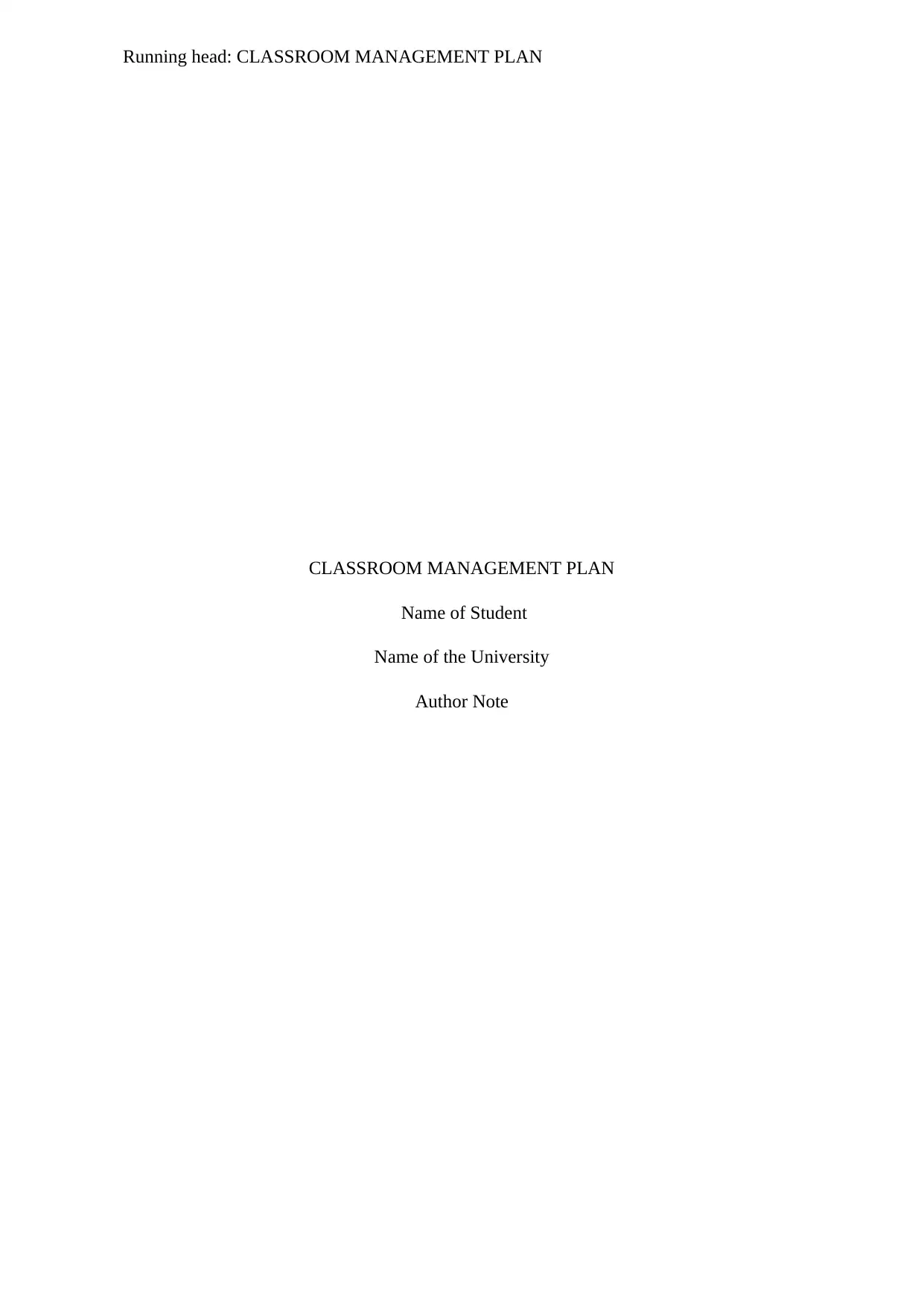
Running head: CLASSROOM MANAGEMENT PLAN
CLASSROOM MANAGEMENT PLAN
Name of Student
Name of the University
Author Note
CLASSROOM MANAGEMENT PLAN
Name of Student
Name of the University
Author Note
Paraphrase This Document
Need a fresh take? Get an instant paraphrase of this document with our AI Paraphraser
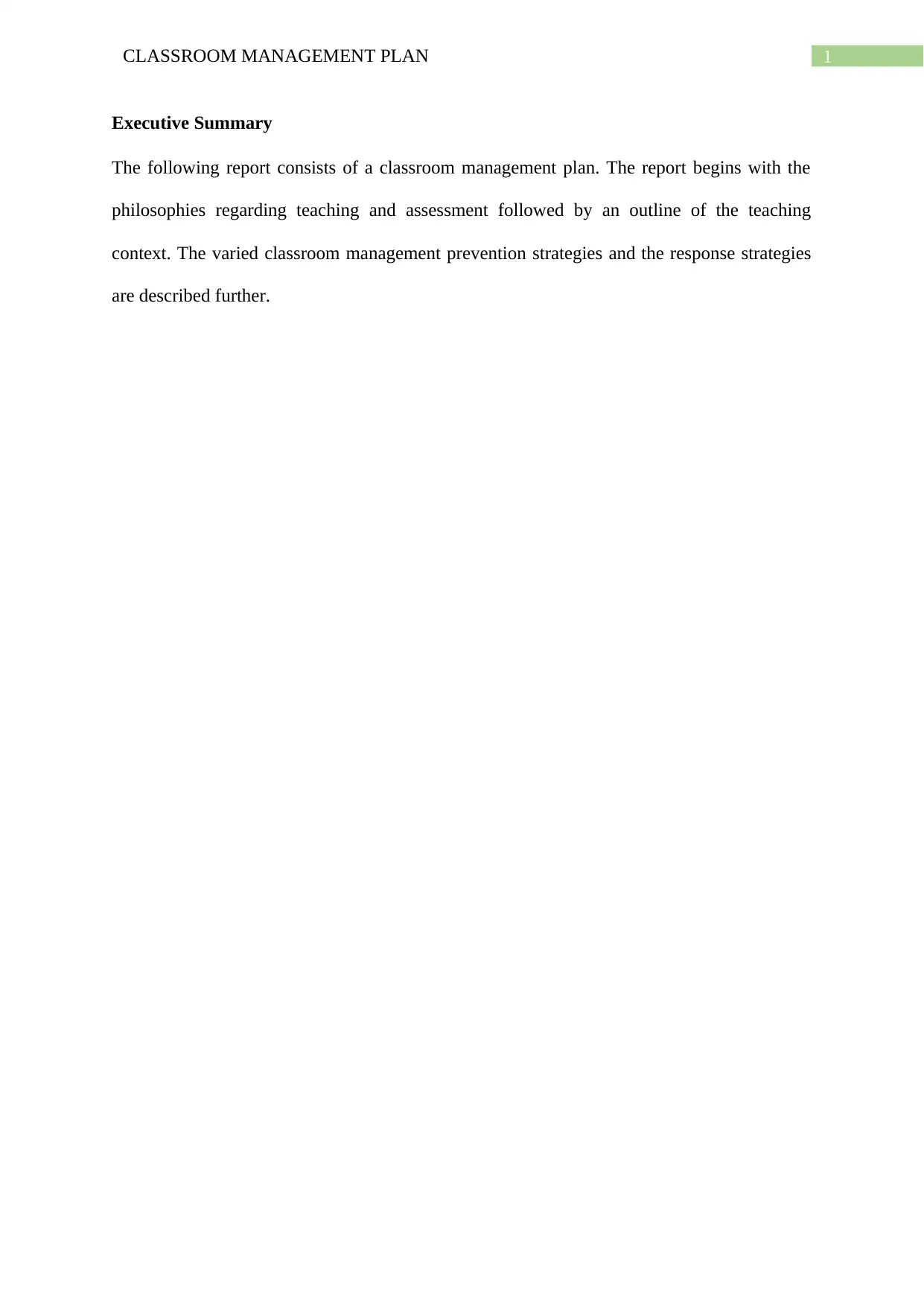
1CLASSROOM MANAGEMENT PLAN
Executive Summary
The following report consists of a classroom management plan. The report begins with the
philosophies regarding teaching and assessment followed by an outline of the teaching
context. The varied classroom management prevention strategies and the response strategies
are described further.
Executive Summary
The following report consists of a classroom management plan. The report begins with the
philosophies regarding teaching and assessment followed by an outline of the teaching
context. The varied classroom management prevention strategies and the response strategies
are described further.
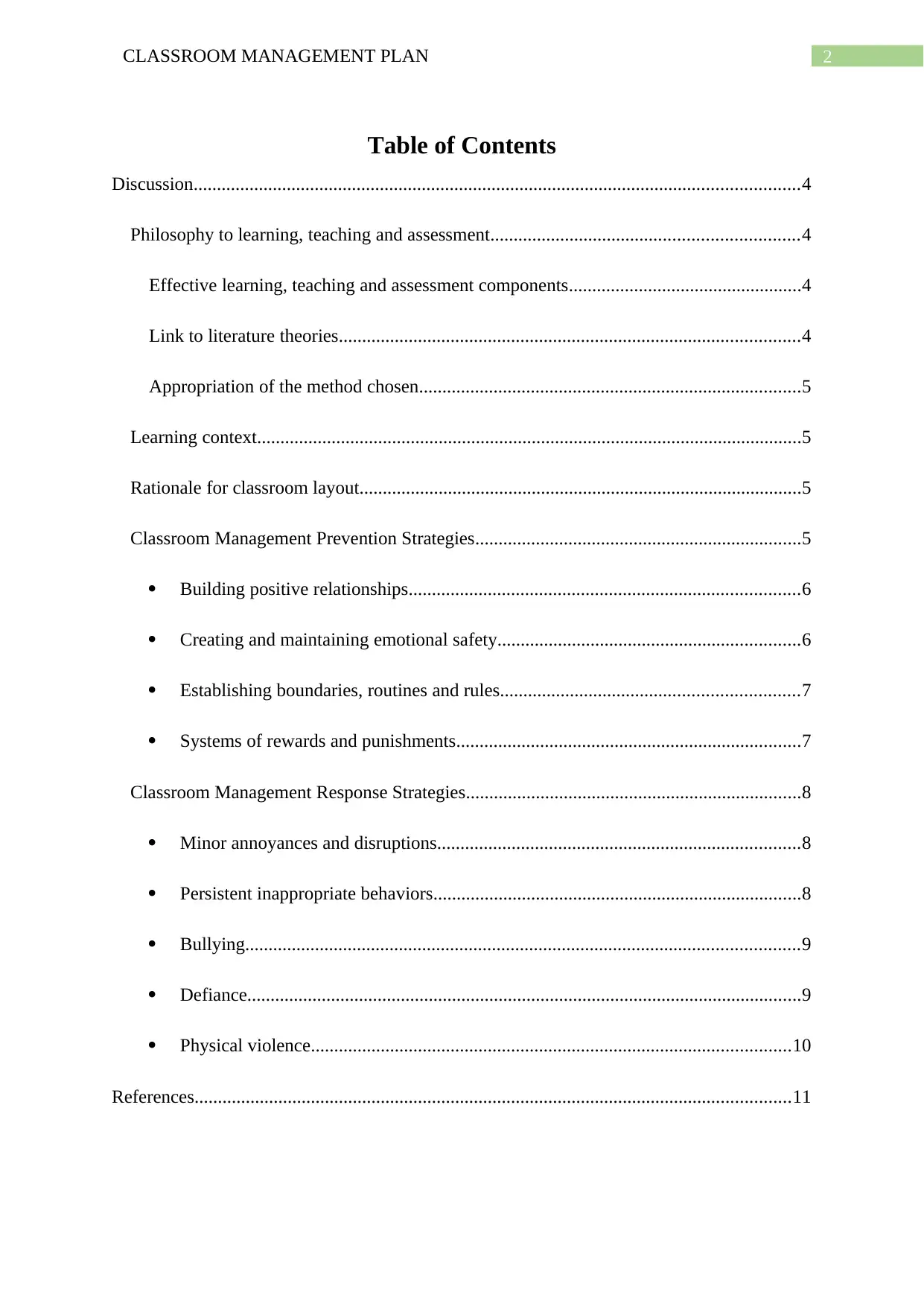
2CLASSROOM MANAGEMENT PLAN
Table of Contents
Discussion..................................................................................................................................4
Philosophy to learning, teaching and assessment..................................................................4
Effective learning, teaching and assessment components..................................................4
Link to literature theories...................................................................................................4
Appropriation of the method chosen..................................................................................5
Learning context.....................................................................................................................5
Rationale for classroom layout...............................................................................................5
Classroom Management Prevention Strategies......................................................................5
Building positive relationships....................................................................................6
Creating and maintaining emotional safety.................................................................6
Establishing boundaries, routines and rules................................................................7
Systems of rewards and punishments..........................................................................7
Classroom Management Response Strategies........................................................................8
Minor annoyances and disruptions..............................................................................8
Persistent inappropriate behaviors...............................................................................8
Bullying.......................................................................................................................9
Defiance.......................................................................................................................9
Physical violence.......................................................................................................10
References................................................................................................................................11
Table of Contents
Discussion..................................................................................................................................4
Philosophy to learning, teaching and assessment..................................................................4
Effective learning, teaching and assessment components..................................................4
Link to literature theories...................................................................................................4
Appropriation of the method chosen..................................................................................5
Learning context.....................................................................................................................5
Rationale for classroom layout...............................................................................................5
Classroom Management Prevention Strategies......................................................................5
Building positive relationships....................................................................................6
Creating and maintaining emotional safety.................................................................6
Establishing boundaries, routines and rules................................................................7
Systems of rewards and punishments..........................................................................7
Classroom Management Response Strategies........................................................................8
Minor annoyances and disruptions..............................................................................8
Persistent inappropriate behaviors...............................................................................8
Bullying.......................................................................................................................9
Defiance.......................................................................................................................9
Physical violence.......................................................................................................10
References................................................................................................................................11
⊘ This is a preview!⊘
Do you want full access?
Subscribe today to unlock all pages.

Trusted by 1+ million students worldwide
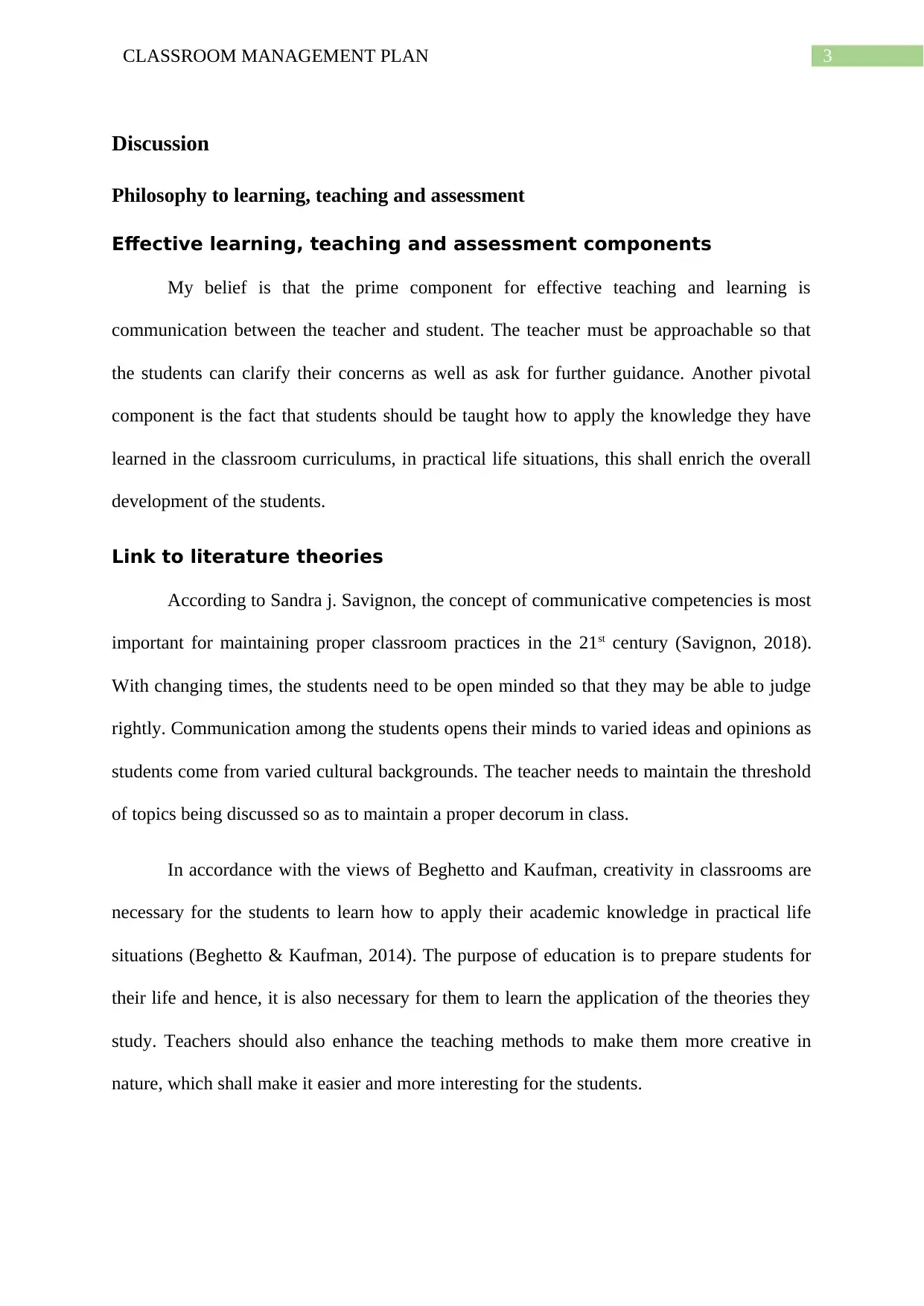
3CLASSROOM MANAGEMENT PLAN
Discussion
Philosophy to learning, teaching and assessment
Effective learning, teaching and assessment components
My belief is that the prime component for effective teaching and learning is
communication between the teacher and student. The teacher must be approachable so that
the students can clarify their concerns as well as ask for further guidance. Another pivotal
component is the fact that students should be taught how to apply the knowledge they have
learned in the classroom curriculums, in practical life situations, this shall enrich the overall
development of the students.
Link to literature theories
According to Sandra j. Savignon, the concept of communicative competencies is most
important for maintaining proper classroom practices in the 21st century (Savignon, 2018).
With changing times, the students need to be open minded so that they may be able to judge
rightly. Communication among the students opens their minds to varied ideas and opinions as
students come from varied cultural backgrounds. The teacher needs to maintain the threshold
of topics being discussed so as to maintain a proper decorum in class.
In accordance with the views of Beghetto and Kaufman, creativity in classrooms are
necessary for the students to learn how to apply their academic knowledge in practical life
situations (Beghetto & Kaufman, 2014). The purpose of education is to prepare students for
their life and hence, it is also necessary for them to learn the application of the theories they
study. Teachers should also enhance the teaching methods to make them more creative in
nature, which shall make it easier and more interesting for the students.
Discussion
Philosophy to learning, teaching and assessment
Effective learning, teaching and assessment components
My belief is that the prime component for effective teaching and learning is
communication between the teacher and student. The teacher must be approachable so that
the students can clarify their concerns as well as ask for further guidance. Another pivotal
component is the fact that students should be taught how to apply the knowledge they have
learned in the classroom curriculums, in practical life situations, this shall enrich the overall
development of the students.
Link to literature theories
According to Sandra j. Savignon, the concept of communicative competencies is most
important for maintaining proper classroom practices in the 21st century (Savignon, 2018).
With changing times, the students need to be open minded so that they may be able to judge
rightly. Communication among the students opens their minds to varied ideas and opinions as
students come from varied cultural backgrounds. The teacher needs to maintain the threshold
of topics being discussed so as to maintain a proper decorum in class.
In accordance with the views of Beghetto and Kaufman, creativity in classrooms are
necessary for the students to learn how to apply their academic knowledge in practical life
situations (Beghetto & Kaufman, 2014). The purpose of education is to prepare students for
their life and hence, it is also necessary for them to learn the application of the theories they
study. Teachers should also enhance the teaching methods to make them more creative in
nature, which shall make it easier and more interesting for the students.
Paraphrase This Document
Need a fresh take? Get an instant paraphrase of this document with our AI Paraphraser
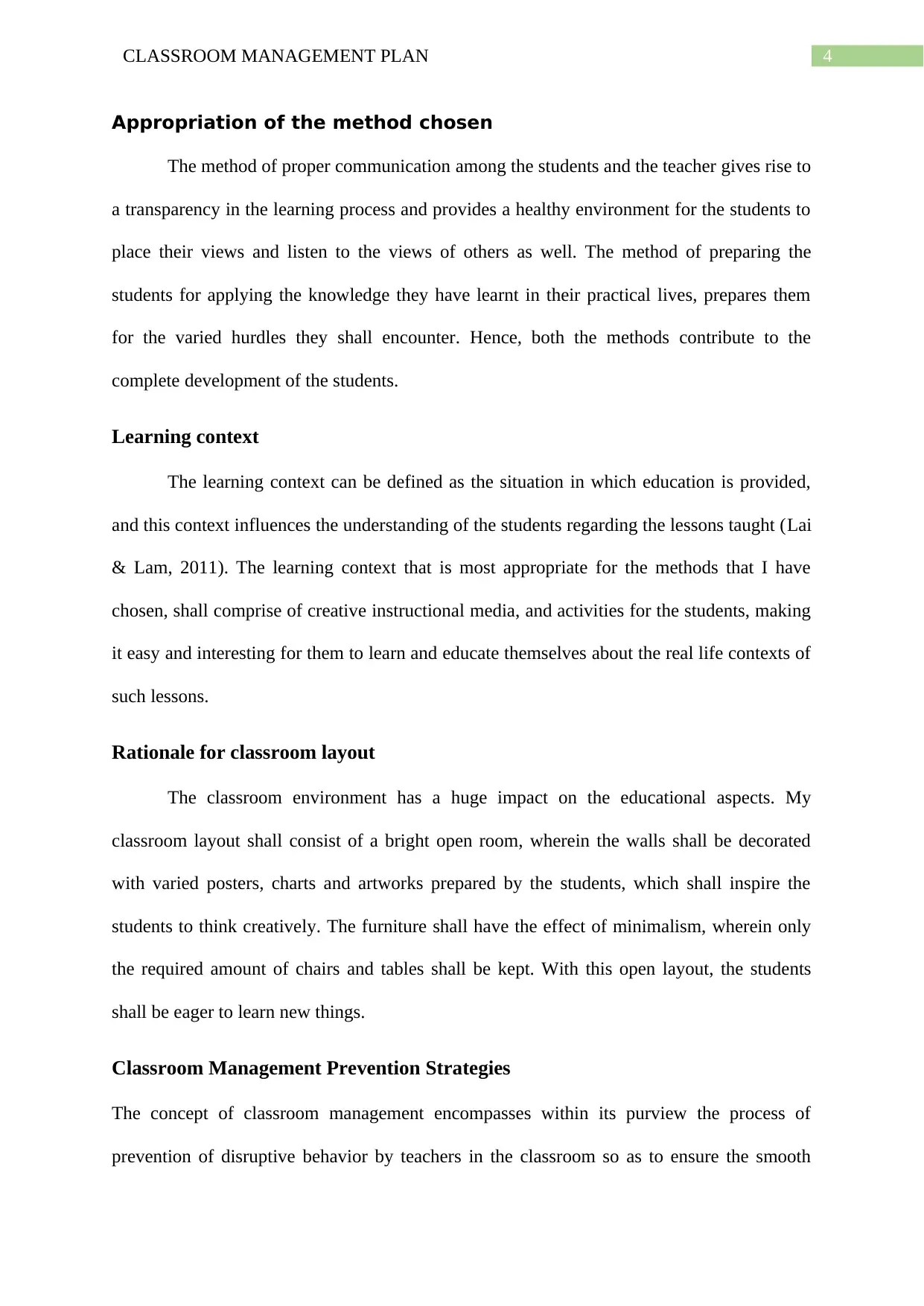
4CLASSROOM MANAGEMENT PLAN
Appropriation of the method chosen
The method of proper communication among the students and the teacher gives rise to
a transparency in the learning process and provides a healthy environment for the students to
place their views and listen to the views of others as well. The method of preparing the
students for applying the knowledge they have learnt in their practical lives, prepares them
for the varied hurdles they shall encounter. Hence, both the methods contribute to the
complete development of the students.
Learning context
The learning context can be defined as the situation in which education is provided,
and this context influences the understanding of the students regarding the lessons taught (Lai
& Lam, 2011). The learning context that is most appropriate for the methods that I have
chosen, shall comprise of creative instructional media, and activities for the students, making
it easy and interesting for them to learn and educate themselves about the real life contexts of
such lessons.
Rationale for classroom layout
The classroom environment has a huge impact on the educational aspects. My
classroom layout shall consist of a bright open room, wherein the walls shall be decorated
with varied posters, charts and artworks prepared by the students, which shall inspire the
students to think creatively. The furniture shall have the effect of minimalism, wherein only
the required amount of chairs and tables shall be kept. With this open layout, the students
shall be eager to learn new things.
Classroom Management Prevention Strategies
The concept of classroom management encompasses within its purview the process of
prevention of disruptive behavior by teachers in the classroom so as to ensure the smooth
Appropriation of the method chosen
The method of proper communication among the students and the teacher gives rise to
a transparency in the learning process and provides a healthy environment for the students to
place their views and listen to the views of others as well. The method of preparing the
students for applying the knowledge they have learnt in their practical lives, prepares them
for the varied hurdles they shall encounter. Hence, both the methods contribute to the
complete development of the students.
Learning context
The learning context can be defined as the situation in which education is provided,
and this context influences the understanding of the students regarding the lessons taught (Lai
& Lam, 2011). The learning context that is most appropriate for the methods that I have
chosen, shall comprise of creative instructional media, and activities for the students, making
it easy and interesting for them to learn and educate themselves about the real life contexts of
such lessons.
Rationale for classroom layout
The classroom environment has a huge impact on the educational aspects. My
classroom layout shall consist of a bright open room, wherein the walls shall be decorated
with varied posters, charts and artworks prepared by the students, which shall inspire the
students to think creatively. The furniture shall have the effect of minimalism, wherein only
the required amount of chairs and tables shall be kept. With this open layout, the students
shall be eager to learn new things.
Classroom Management Prevention Strategies
The concept of classroom management encompasses within its purview the process of
prevention of disruptive behavior by teachers in the classroom so as to ensure the smooth
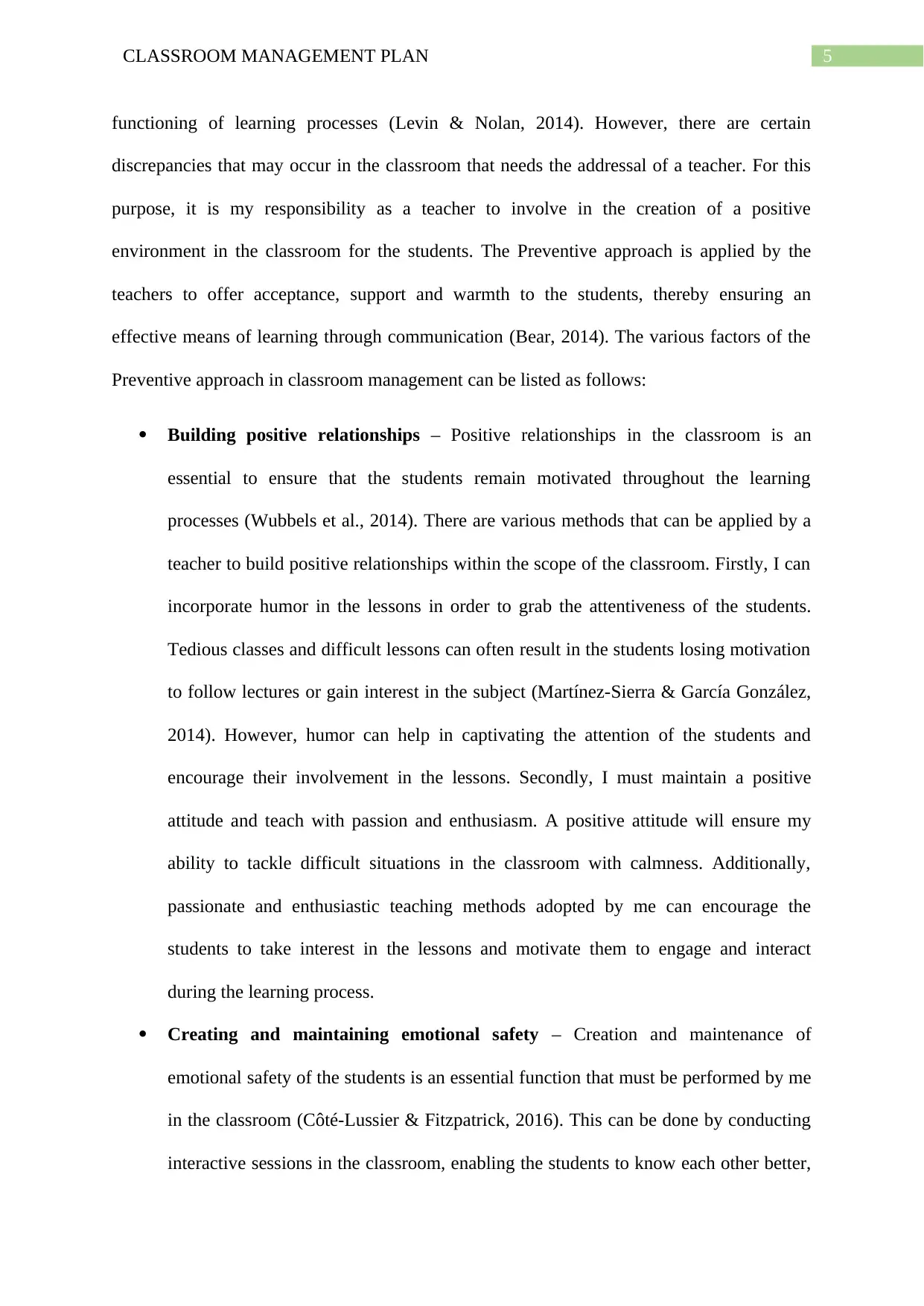
5CLASSROOM MANAGEMENT PLAN
functioning of learning processes (Levin & Nolan, 2014). However, there are certain
discrepancies that may occur in the classroom that needs the addressal of a teacher. For this
purpose, it is my responsibility as a teacher to involve in the creation of a positive
environment in the classroom for the students. The Preventive approach is applied by the
teachers to offer acceptance, support and warmth to the students, thereby ensuring an
effective means of learning through communication (Bear, 2014). The various factors of the
Preventive approach in classroom management can be listed as follows:
Building positive relationships – Positive relationships in the classroom is an
essential to ensure that the students remain motivated throughout the learning
processes (Wubbels et al., 2014). There are various methods that can be applied by a
teacher to build positive relationships within the scope of the classroom. Firstly, I can
incorporate humor in the lessons in order to grab the attentiveness of the students.
Tedious classes and difficult lessons can often result in the students losing motivation
to follow lectures or gain interest in the subject (Martínez-Sierra & García González,
2014). However, humor can help in captivating the attention of the students and
encourage their involvement in the lessons. Secondly, I must maintain a positive
attitude and teach with passion and enthusiasm. A positive attitude will ensure my
ability to tackle difficult situations in the classroom with calmness. Additionally,
passionate and enthusiastic teaching methods adopted by me can encourage the
students to take interest in the lessons and motivate them to engage and interact
during the learning process.
Creating and maintaining emotional safety – Creation and maintenance of
emotional safety of the students is an essential function that must be performed by me
in the classroom (Côté-Lussier & Fitzpatrick, 2016). This can be done by conducting
interactive sessions in the classroom, enabling the students to know each other better,
functioning of learning processes (Levin & Nolan, 2014). However, there are certain
discrepancies that may occur in the classroom that needs the addressal of a teacher. For this
purpose, it is my responsibility as a teacher to involve in the creation of a positive
environment in the classroom for the students. The Preventive approach is applied by the
teachers to offer acceptance, support and warmth to the students, thereby ensuring an
effective means of learning through communication (Bear, 2014). The various factors of the
Preventive approach in classroom management can be listed as follows:
Building positive relationships – Positive relationships in the classroom is an
essential to ensure that the students remain motivated throughout the learning
processes (Wubbels et al., 2014). There are various methods that can be applied by a
teacher to build positive relationships within the scope of the classroom. Firstly, I can
incorporate humor in the lessons in order to grab the attentiveness of the students.
Tedious classes and difficult lessons can often result in the students losing motivation
to follow lectures or gain interest in the subject (Martínez-Sierra & García González,
2014). However, humor can help in captivating the attention of the students and
encourage their involvement in the lessons. Secondly, I must maintain a positive
attitude and teach with passion and enthusiasm. A positive attitude will ensure my
ability to tackle difficult situations in the classroom with calmness. Additionally,
passionate and enthusiastic teaching methods adopted by me can encourage the
students to take interest in the lessons and motivate them to engage and interact
during the learning process.
Creating and maintaining emotional safety – Creation and maintenance of
emotional safety of the students is an essential function that must be performed by me
in the classroom (Côté-Lussier & Fitzpatrick, 2016). This can be done by conducting
interactive sessions in the classroom, enabling the students to know each other better,
⊘ This is a preview!⊘
Do you want full access?
Subscribe today to unlock all pages.

Trusted by 1+ million students worldwide
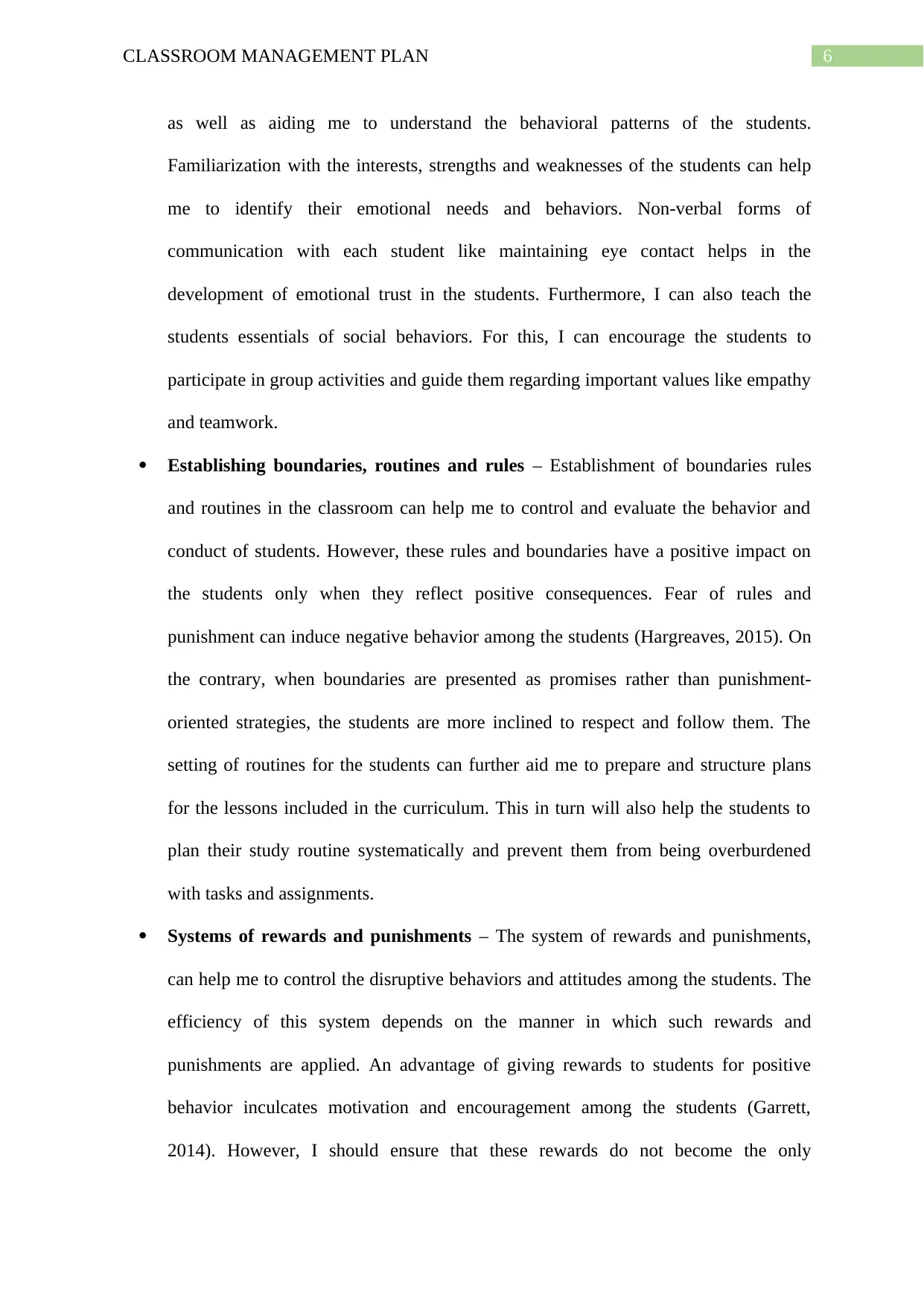
6CLASSROOM MANAGEMENT PLAN
as well as aiding me to understand the behavioral patterns of the students.
Familiarization with the interests, strengths and weaknesses of the students can help
me to identify their emotional needs and behaviors. Non-verbal forms of
communication with each student like maintaining eye contact helps in the
development of emotional trust in the students. Furthermore, I can also teach the
students essentials of social behaviors. For this, I can encourage the students to
participate in group activities and guide them regarding important values like empathy
and teamwork.
Establishing boundaries, routines and rules – Establishment of boundaries rules
and routines in the classroom can help me to control and evaluate the behavior and
conduct of students. However, these rules and boundaries have a positive impact on
the students only when they reflect positive consequences. Fear of rules and
punishment can induce negative behavior among the students (Hargreaves, 2015). On
the contrary, when boundaries are presented as promises rather than punishment-
oriented strategies, the students are more inclined to respect and follow them. The
setting of routines for the students can further aid me to prepare and structure plans
for the lessons included in the curriculum. This in turn will also help the students to
plan their study routine systematically and prevent them from being overburdened
with tasks and assignments.
Systems of rewards and punishments – The system of rewards and punishments,
can help me to control the disruptive behaviors and attitudes among the students. The
efficiency of this system depends on the manner in which such rewards and
punishments are applied. An advantage of giving rewards to students for positive
behavior inculcates motivation and encouragement among the students (Garrett,
2014). However, I should ensure that these rewards do not become the only
as well as aiding me to understand the behavioral patterns of the students.
Familiarization with the interests, strengths and weaknesses of the students can help
me to identify their emotional needs and behaviors. Non-verbal forms of
communication with each student like maintaining eye contact helps in the
development of emotional trust in the students. Furthermore, I can also teach the
students essentials of social behaviors. For this, I can encourage the students to
participate in group activities and guide them regarding important values like empathy
and teamwork.
Establishing boundaries, routines and rules – Establishment of boundaries rules
and routines in the classroom can help me to control and evaluate the behavior and
conduct of students. However, these rules and boundaries have a positive impact on
the students only when they reflect positive consequences. Fear of rules and
punishment can induce negative behavior among the students (Hargreaves, 2015). On
the contrary, when boundaries are presented as promises rather than punishment-
oriented strategies, the students are more inclined to respect and follow them. The
setting of routines for the students can further aid me to prepare and structure plans
for the lessons included in the curriculum. This in turn will also help the students to
plan their study routine systematically and prevent them from being overburdened
with tasks and assignments.
Systems of rewards and punishments – The system of rewards and punishments,
can help me to control the disruptive behaviors and attitudes among the students. The
efficiency of this system depends on the manner in which such rewards and
punishments are applied. An advantage of giving rewards to students for positive
behavior inculcates motivation and encouragement among the students (Garrett,
2014). However, I should ensure that these rewards do not become the only
Paraphrase This Document
Need a fresh take? Get an instant paraphrase of this document with our AI Paraphraser
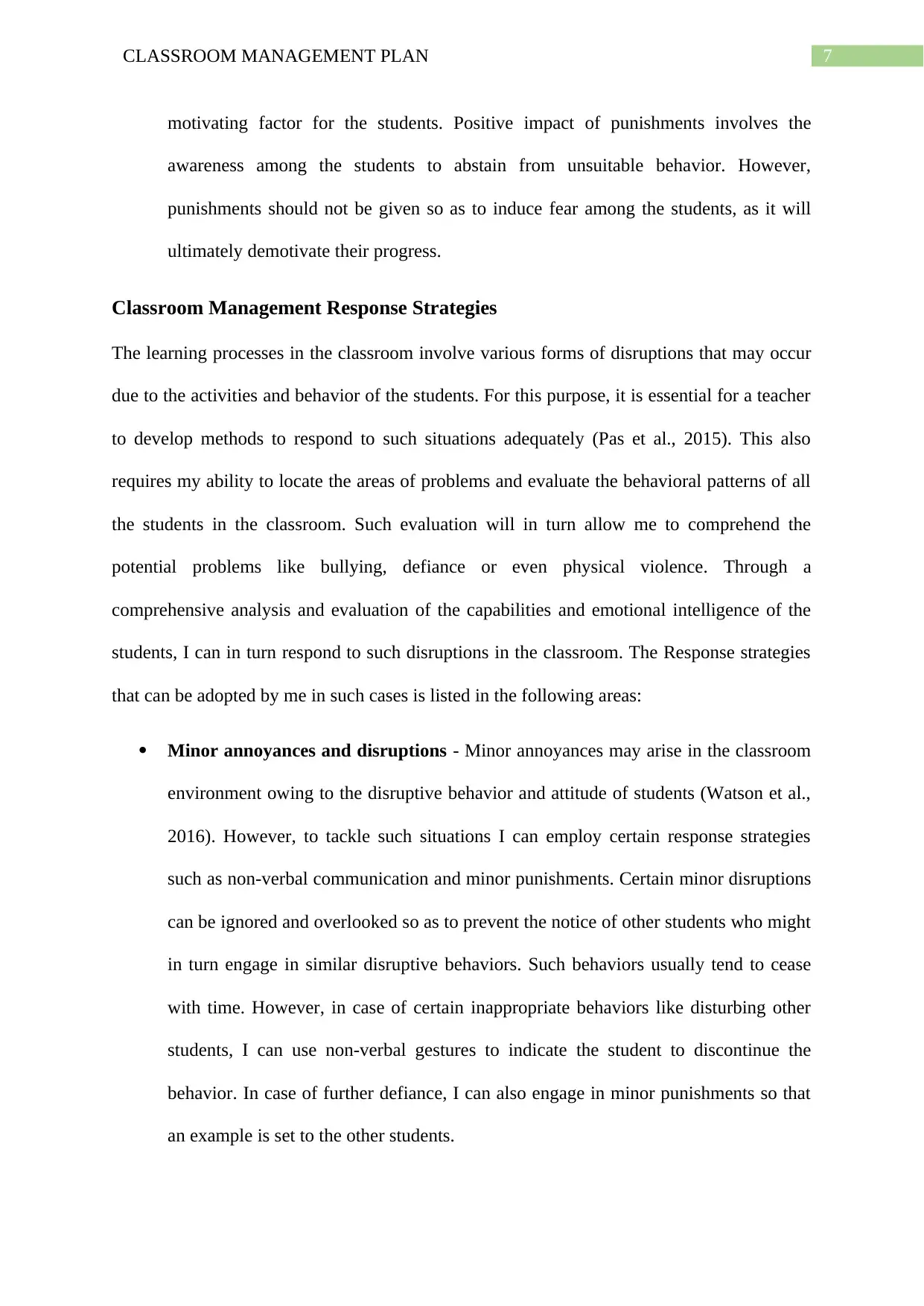
7CLASSROOM MANAGEMENT PLAN
motivating factor for the students. Positive impact of punishments involves the
awareness among the students to abstain from unsuitable behavior. However,
punishments should not be given so as to induce fear among the students, as it will
ultimately demotivate their progress.
Classroom Management Response Strategies
The learning processes in the classroom involve various forms of disruptions that may occur
due to the activities and behavior of the students. For this purpose, it is essential for a teacher
to develop methods to respond to such situations adequately (Pas et al., 2015). This also
requires my ability to locate the areas of problems and evaluate the behavioral patterns of all
the students in the classroom. Such evaluation will in turn allow me to comprehend the
potential problems like bullying, defiance or even physical violence. Through a
comprehensive analysis and evaluation of the capabilities and emotional intelligence of the
students, I can in turn respond to such disruptions in the classroom. The Response strategies
that can be adopted by me in such cases is listed in the following areas:
Minor annoyances and disruptions - Minor annoyances may arise in the classroom
environment owing to the disruptive behavior and attitude of students (Watson et al.,
2016). However, to tackle such situations I can employ certain response strategies
such as non-verbal communication and minor punishments. Certain minor disruptions
can be ignored and overlooked so as to prevent the notice of other students who might
in turn engage in similar disruptive behaviors. Such behaviors usually tend to cease
with time. However, in case of certain inappropriate behaviors like disturbing other
students, I can use non-verbal gestures to indicate the student to discontinue the
behavior. In case of further defiance, I can also engage in minor punishments so that
an example is set to the other students.
motivating factor for the students. Positive impact of punishments involves the
awareness among the students to abstain from unsuitable behavior. However,
punishments should not be given so as to induce fear among the students, as it will
ultimately demotivate their progress.
Classroom Management Response Strategies
The learning processes in the classroom involve various forms of disruptions that may occur
due to the activities and behavior of the students. For this purpose, it is essential for a teacher
to develop methods to respond to such situations adequately (Pas et al., 2015). This also
requires my ability to locate the areas of problems and evaluate the behavioral patterns of all
the students in the classroom. Such evaluation will in turn allow me to comprehend the
potential problems like bullying, defiance or even physical violence. Through a
comprehensive analysis and evaluation of the capabilities and emotional intelligence of the
students, I can in turn respond to such disruptions in the classroom. The Response strategies
that can be adopted by me in such cases is listed in the following areas:
Minor annoyances and disruptions - Minor annoyances may arise in the classroom
environment owing to the disruptive behavior and attitude of students (Watson et al.,
2016). However, to tackle such situations I can employ certain response strategies
such as non-verbal communication and minor punishments. Certain minor disruptions
can be ignored and overlooked so as to prevent the notice of other students who might
in turn engage in similar disruptive behaviors. Such behaviors usually tend to cease
with time. However, in case of certain inappropriate behaviors like disturbing other
students, I can use non-verbal gestures to indicate the student to discontinue the
behavior. In case of further defiance, I can also engage in minor punishments so that
an example is set to the other students.
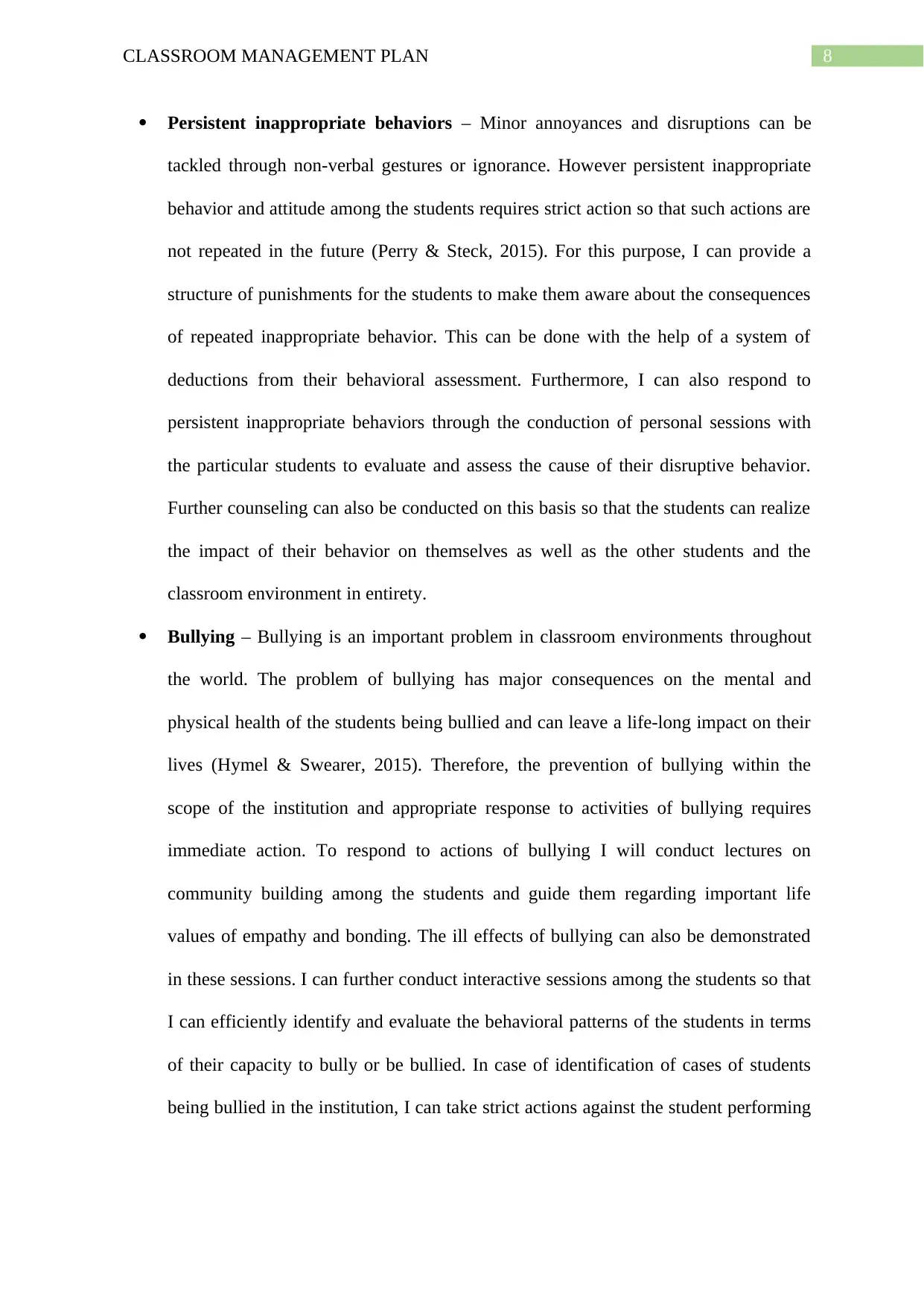
8CLASSROOM MANAGEMENT PLAN
Persistent inappropriate behaviors – Minor annoyances and disruptions can be
tackled through non-verbal gestures or ignorance. However persistent inappropriate
behavior and attitude among the students requires strict action so that such actions are
not repeated in the future (Perry & Steck, 2015). For this purpose, I can provide a
structure of punishments for the students to make them aware about the consequences
of repeated inappropriate behavior. This can be done with the help of a system of
deductions from their behavioral assessment. Furthermore, I can also respond to
persistent inappropriate behaviors through the conduction of personal sessions with
the particular students to evaluate and assess the cause of their disruptive behavior.
Further counseling can also be conducted on this basis so that the students can realize
the impact of their behavior on themselves as well as the other students and the
classroom environment in entirety.
Bullying – Bullying is an important problem in classroom environments throughout
the world. The problem of bullying has major consequences on the mental and
physical health of the students being bullied and can leave a life-long impact on their
lives (Hymel & Swearer, 2015). Therefore, the prevention of bullying within the
scope of the institution and appropriate response to activities of bullying requires
immediate action. To respond to actions of bullying I will conduct lectures on
community building among the students and guide them regarding important life
values of empathy and bonding. The ill effects of bullying can also be demonstrated
in these sessions. I can further conduct interactive sessions among the students so that
I can efficiently identify and evaluate the behavioral patterns of the students in terms
of their capacity to bully or be bullied. In case of identification of cases of students
being bullied in the institution, I can take strict actions against the student performing
Persistent inappropriate behaviors – Minor annoyances and disruptions can be
tackled through non-verbal gestures or ignorance. However persistent inappropriate
behavior and attitude among the students requires strict action so that such actions are
not repeated in the future (Perry & Steck, 2015). For this purpose, I can provide a
structure of punishments for the students to make them aware about the consequences
of repeated inappropriate behavior. This can be done with the help of a system of
deductions from their behavioral assessment. Furthermore, I can also respond to
persistent inappropriate behaviors through the conduction of personal sessions with
the particular students to evaluate and assess the cause of their disruptive behavior.
Further counseling can also be conducted on this basis so that the students can realize
the impact of their behavior on themselves as well as the other students and the
classroom environment in entirety.
Bullying – Bullying is an important problem in classroom environments throughout
the world. The problem of bullying has major consequences on the mental and
physical health of the students being bullied and can leave a life-long impact on their
lives (Hymel & Swearer, 2015). Therefore, the prevention of bullying within the
scope of the institution and appropriate response to activities of bullying requires
immediate action. To respond to actions of bullying I will conduct lectures on
community building among the students and guide them regarding important life
values of empathy and bonding. The ill effects of bullying can also be demonstrated
in these sessions. I can further conduct interactive sessions among the students so that
I can efficiently identify and evaluate the behavioral patterns of the students in terms
of their capacity to bully or be bullied. In case of identification of cases of students
being bullied in the institution, I can take strict actions against the student performing
⊘ This is a preview!⊘
Do you want full access?
Subscribe today to unlock all pages.

Trusted by 1+ million students worldwide
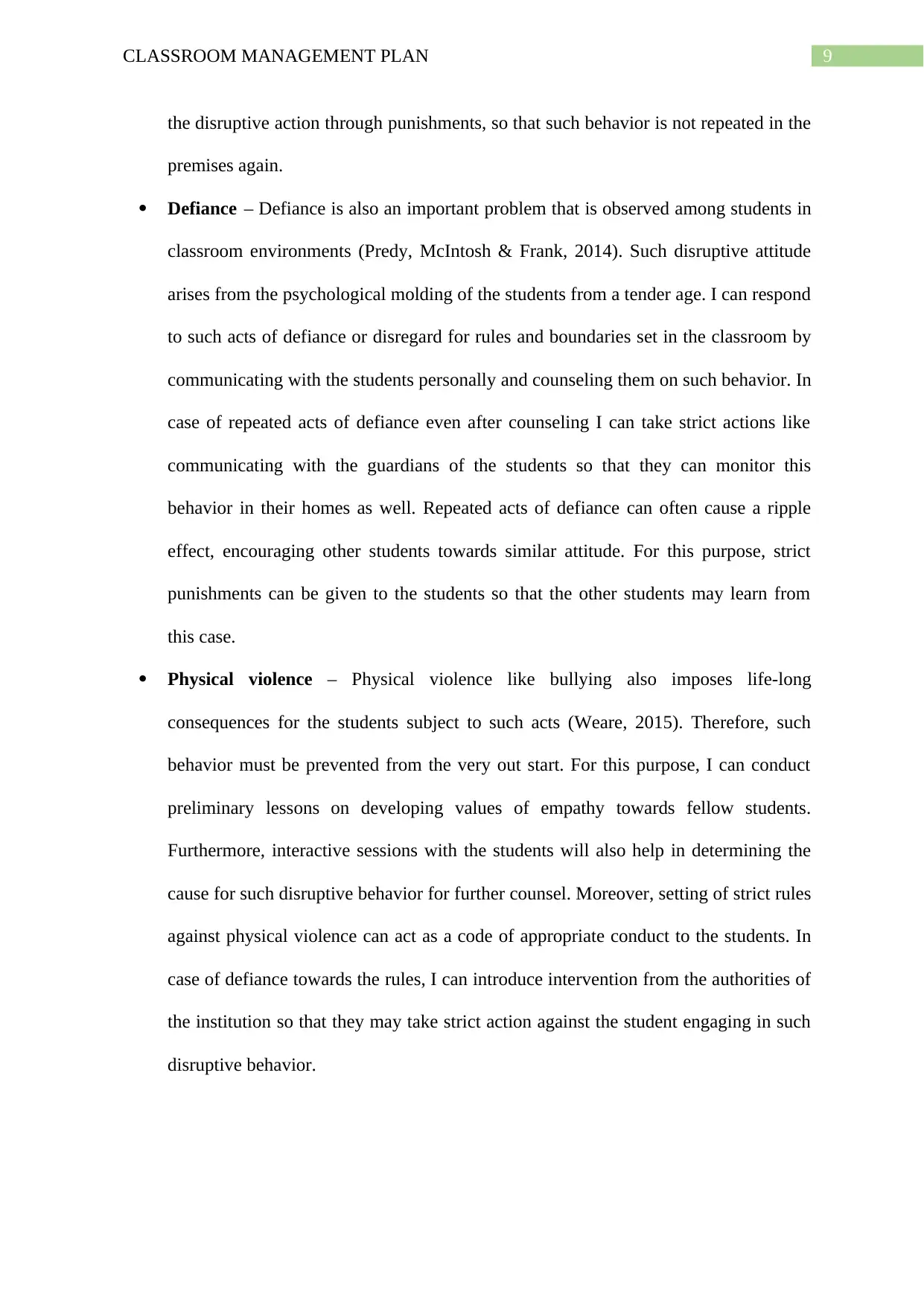
9CLASSROOM MANAGEMENT PLAN
the disruptive action through punishments, so that such behavior is not repeated in the
premises again.
Defiance – Defiance is also an important problem that is observed among students in
classroom environments (Predy, McIntosh & Frank, 2014). Such disruptive attitude
arises from the psychological molding of the students from a tender age. I can respond
to such acts of defiance or disregard for rules and boundaries set in the classroom by
communicating with the students personally and counseling them on such behavior. In
case of repeated acts of defiance even after counseling I can take strict actions like
communicating with the guardians of the students so that they can monitor this
behavior in their homes as well. Repeated acts of defiance can often cause a ripple
effect, encouraging other students towards similar attitude. For this purpose, strict
punishments can be given to the students so that the other students may learn from
this case.
Physical violence – Physical violence like bullying also imposes life-long
consequences for the students subject to such acts (Weare, 2015). Therefore, such
behavior must be prevented from the very out start. For this purpose, I can conduct
preliminary lessons on developing values of empathy towards fellow students.
Furthermore, interactive sessions with the students will also help in determining the
cause for such disruptive behavior for further counsel. Moreover, setting of strict rules
against physical violence can act as a code of appropriate conduct to the students. In
case of defiance towards the rules, I can introduce intervention from the authorities of
the institution so that they may take strict action against the student engaging in such
disruptive behavior.
the disruptive action through punishments, so that such behavior is not repeated in the
premises again.
Defiance – Defiance is also an important problem that is observed among students in
classroom environments (Predy, McIntosh & Frank, 2014). Such disruptive attitude
arises from the psychological molding of the students from a tender age. I can respond
to such acts of defiance or disregard for rules and boundaries set in the classroom by
communicating with the students personally and counseling them on such behavior. In
case of repeated acts of defiance even after counseling I can take strict actions like
communicating with the guardians of the students so that they can monitor this
behavior in their homes as well. Repeated acts of defiance can often cause a ripple
effect, encouraging other students towards similar attitude. For this purpose, strict
punishments can be given to the students so that the other students may learn from
this case.
Physical violence – Physical violence like bullying also imposes life-long
consequences for the students subject to such acts (Weare, 2015). Therefore, such
behavior must be prevented from the very out start. For this purpose, I can conduct
preliminary lessons on developing values of empathy towards fellow students.
Furthermore, interactive sessions with the students will also help in determining the
cause for such disruptive behavior for further counsel. Moreover, setting of strict rules
against physical violence can act as a code of appropriate conduct to the students. In
case of defiance towards the rules, I can introduce intervention from the authorities of
the institution so that they may take strict action against the student engaging in such
disruptive behavior.
Paraphrase This Document
Need a fresh take? Get an instant paraphrase of this document with our AI Paraphraser
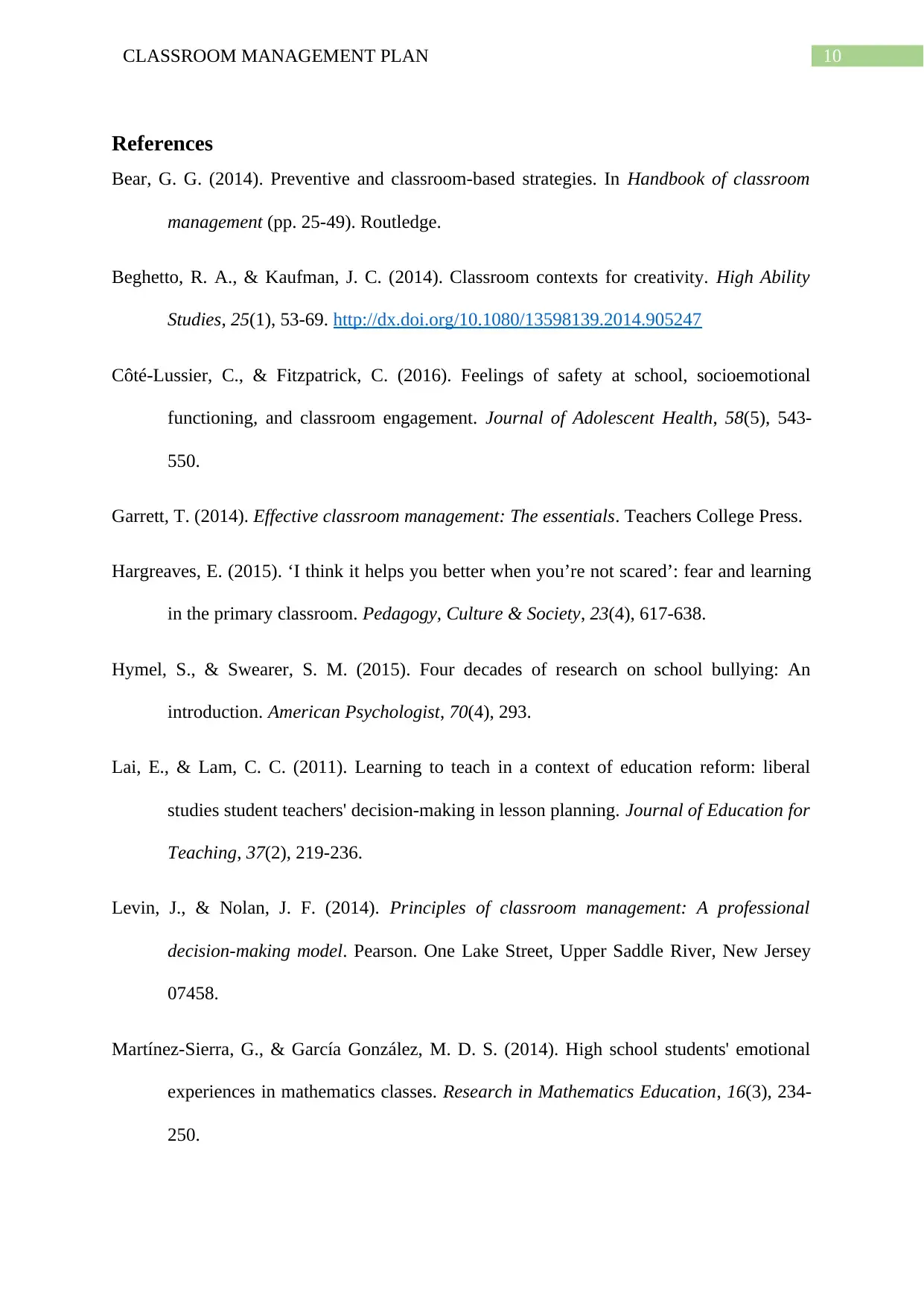
10CLASSROOM MANAGEMENT PLAN
References
Bear, G. G. (2014). Preventive and classroom-based strategies. In Handbook of classroom
management (pp. 25-49). Routledge.
Beghetto, R. A., & Kaufman, J. C. (2014). Classroom contexts for creativity. High Ability
Studies, 25(1), 53-69. http://dx.doi.org/10.1080/13598139.2014.905247
Côté-Lussier, C., & Fitzpatrick, C. (2016). Feelings of safety at school, socioemotional
functioning, and classroom engagement. Journal of Adolescent Health, 58(5), 543-
550.
Garrett, T. (2014). Effective classroom management: The essentials. Teachers College Press.
Hargreaves, E. (2015). ‘I think it helps you better when you’re not scared’: fear and learning
in the primary classroom. Pedagogy, Culture & Society, 23(4), 617-638.
Hymel, S., & Swearer, S. M. (2015). Four decades of research on school bullying: An
introduction. American Psychologist, 70(4), 293.
Lai, E., & Lam, C. C. (2011). Learning to teach in a context of education reform: liberal
studies student teachers' decision‐making in lesson planning. Journal of Education for
Teaching, 37(2), 219-236.
Levin, J., & Nolan, J. F. (2014). Principles of classroom management: A professional
decision-making model. Pearson. One Lake Street, Upper Saddle River, New Jersey
07458.
Martínez-Sierra, G., & García González, M. D. S. (2014). High school students' emotional
experiences in mathematics classes. Research in Mathematics Education, 16(3), 234-
250.
References
Bear, G. G. (2014). Preventive and classroom-based strategies. In Handbook of classroom
management (pp. 25-49). Routledge.
Beghetto, R. A., & Kaufman, J. C. (2014). Classroom contexts for creativity. High Ability
Studies, 25(1), 53-69. http://dx.doi.org/10.1080/13598139.2014.905247
Côté-Lussier, C., & Fitzpatrick, C. (2016). Feelings of safety at school, socioemotional
functioning, and classroom engagement. Journal of Adolescent Health, 58(5), 543-
550.
Garrett, T. (2014). Effective classroom management: The essentials. Teachers College Press.
Hargreaves, E. (2015). ‘I think it helps you better when you’re not scared’: fear and learning
in the primary classroom. Pedagogy, Culture & Society, 23(4), 617-638.
Hymel, S., & Swearer, S. M. (2015). Four decades of research on school bullying: An
introduction. American Psychologist, 70(4), 293.
Lai, E., & Lam, C. C. (2011). Learning to teach in a context of education reform: liberal
studies student teachers' decision‐making in lesson planning. Journal of Education for
Teaching, 37(2), 219-236.
Levin, J., & Nolan, J. F. (2014). Principles of classroom management: A professional
decision-making model. Pearson. One Lake Street, Upper Saddle River, New Jersey
07458.
Martínez-Sierra, G., & García González, M. D. S. (2014). High school students' emotional
experiences in mathematics classes. Research in Mathematics Education, 16(3), 234-
250.
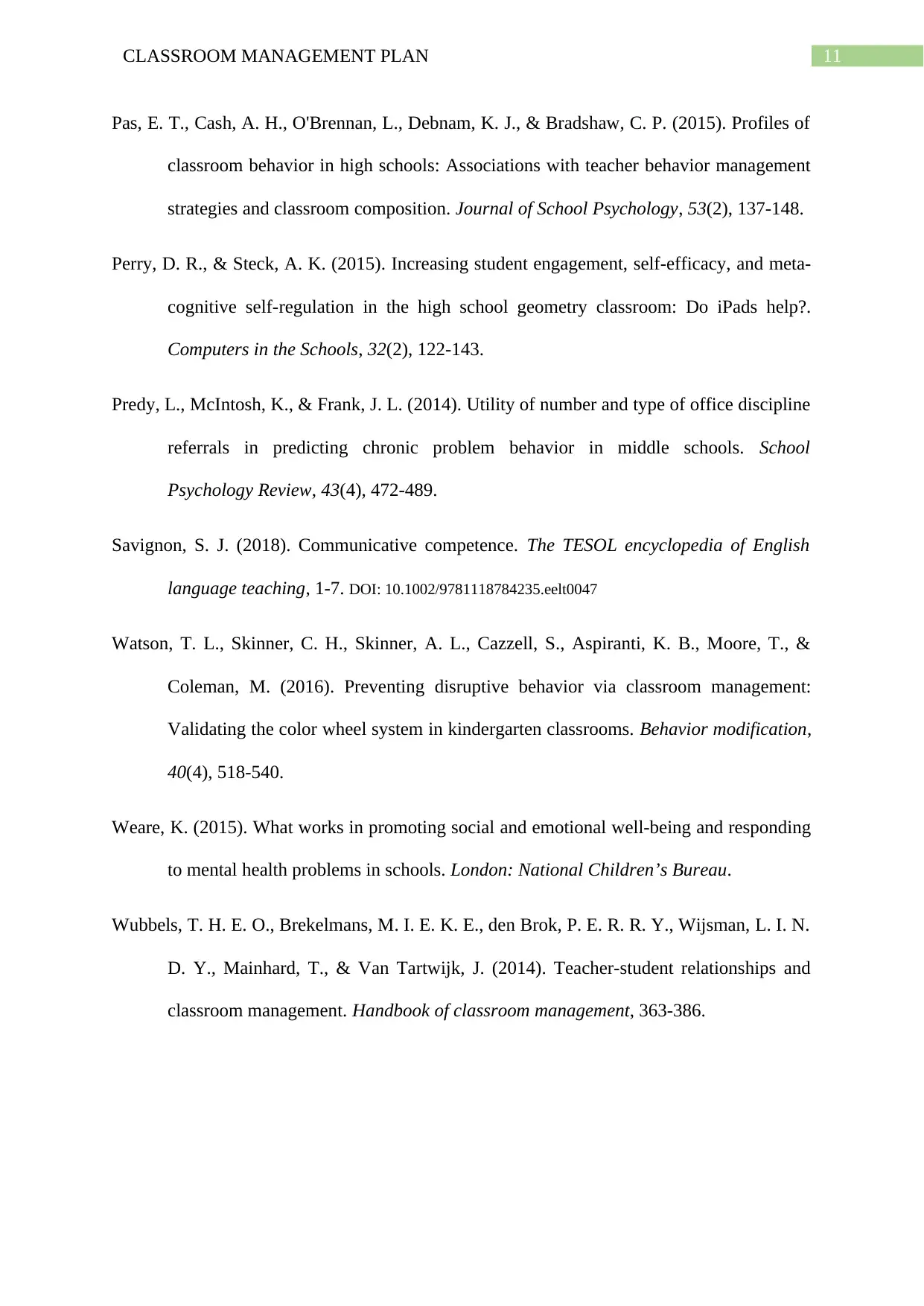
11CLASSROOM MANAGEMENT PLAN
Pas, E. T., Cash, A. H., O'Brennan, L., Debnam, K. J., & Bradshaw, C. P. (2015). Profiles of
classroom behavior in high schools: Associations with teacher behavior management
strategies and classroom composition. Journal of School Psychology, 53(2), 137-148.
Perry, D. R., & Steck, A. K. (2015). Increasing student engagement, self-efficacy, and meta-
cognitive self-regulation in the high school geometry classroom: Do iPads help?.
Computers in the Schools, 32(2), 122-143.
Predy, L., McIntosh, K., & Frank, J. L. (2014). Utility of number and type of office discipline
referrals in predicting chronic problem behavior in middle schools. School
Psychology Review, 43(4), 472-489.
Savignon, S. J. (2018). Communicative competence. The TESOL encyclopedia of English
language teaching, 1-7. DOI: 10.1002/9781118784235.eelt0047
Watson, T. L., Skinner, C. H., Skinner, A. L., Cazzell, S., Aspiranti, K. B., Moore, T., &
Coleman, M. (2016). Preventing disruptive behavior via classroom management:
Validating the color wheel system in kindergarten classrooms. Behavior modification,
40(4), 518-540.
Weare, K. (2015). What works in promoting social and emotional well-being and responding
to mental health problems in schools. London: National Children’s Bureau.
Wubbels, T. H. E. O., Brekelmans, M. I. E. K. E., den Brok, P. E. R. R. Y., Wijsman, L. I. N.
D. Y., Mainhard, T., & Van Tartwijk, J. (2014). Teacher-student relationships and
classroom management. Handbook of classroom management, 363-386.
Pas, E. T., Cash, A. H., O'Brennan, L., Debnam, K. J., & Bradshaw, C. P. (2015). Profiles of
classroom behavior in high schools: Associations with teacher behavior management
strategies and classroom composition. Journal of School Psychology, 53(2), 137-148.
Perry, D. R., & Steck, A. K. (2015). Increasing student engagement, self-efficacy, and meta-
cognitive self-regulation in the high school geometry classroom: Do iPads help?.
Computers in the Schools, 32(2), 122-143.
Predy, L., McIntosh, K., & Frank, J. L. (2014). Utility of number and type of office discipline
referrals in predicting chronic problem behavior in middle schools. School
Psychology Review, 43(4), 472-489.
Savignon, S. J. (2018). Communicative competence. The TESOL encyclopedia of English
language teaching, 1-7. DOI: 10.1002/9781118784235.eelt0047
Watson, T. L., Skinner, C. H., Skinner, A. L., Cazzell, S., Aspiranti, K. B., Moore, T., &
Coleman, M. (2016). Preventing disruptive behavior via classroom management:
Validating the color wheel system in kindergarten classrooms. Behavior modification,
40(4), 518-540.
Weare, K. (2015). What works in promoting social and emotional well-being and responding
to mental health problems in schools. London: National Children’s Bureau.
Wubbels, T. H. E. O., Brekelmans, M. I. E. K. E., den Brok, P. E. R. R. Y., Wijsman, L. I. N.
D. Y., Mainhard, T., & Van Tartwijk, J. (2014). Teacher-student relationships and
classroom management. Handbook of classroom management, 363-386.
⊘ This is a preview!⊘
Do you want full access?
Subscribe today to unlock all pages.

Trusted by 1+ million students worldwide
1 out of 12
Related Documents
Your All-in-One AI-Powered Toolkit for Academic Success.
+13062052269
info@desklib.com
Available 24*7 on WhatsApp / Email
![[object Object]](/_next/static/media/star-bottom.7253800d.svg)
Unlock your academic potential
Copyright © 2020–2025 A2Z Services. All Rights Reserved. Developed and managed by ZUCOL.





